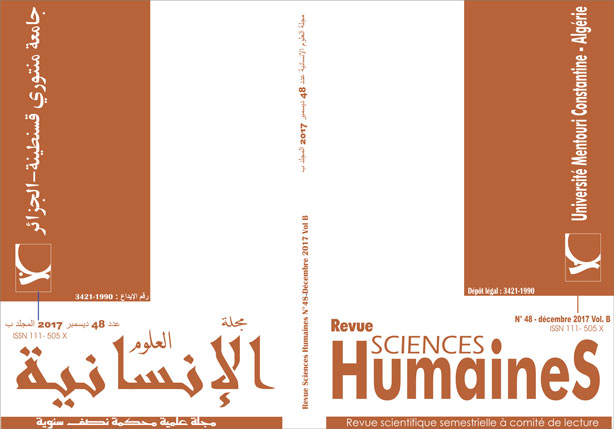Integrating Students’ Own Cultre in the Teaching of Vocabulary
Keywords:
Integrating Students, Own, Cultre, Teaching, VocabularyAbstract
Many researchers make it evident that culture and language are intertwined. The present paper reports on a study about the usefulness of incorporating learners’ own culture in the teaching of English as a foreign language. More specifically, it aims at investigating the impact of using elements and examples from students’ cultural background to help them learn meanings of unknown vocabulary items presented to them for the first time. It is hypothesized that students are more likely to obtain and correctly guess words’ meanings when these appear in a context which is familiar to them. This study takes as sample first-year LMD students at the Department of Arts and English Language, University of Constantine1. The participants take part in two tests where they have to guess the meaning of a number of vocabulary items from context. The example statements used in the first test are taken from the students’ homeland culture and in the second from the host culture. The findings show that including elements from students’ own culture helped them guess the meaning of new words.Downloads
References
Alhasiany, F. (2014) English Language Learners. International Journal of Business and Social Science, 5 (8), 38-43.
Alptekin, C. (1993) Target-language culture in EFL Materials. ELT Journal, 47(2), 136-143.
Barfield, S.C. ; Uzarski, J. (2009). Integrating Indigenous Cultures into English Language Teaching. English Teaching Forum 12(9).
Broemmel, A. D.; Jordan, J.; Whitsett, B. M. (2015) Learning to be Teacher Leaders: A Framework for Assessment, Planning, and Instruction. New York: Routledge
Brooks, N. (1968) Teaching Culture in the Foreign Language Classroom. Foreign Language Annals, l (3), 204-217.
Buttjes, D. (1991) Mediating Languages and Culture: The Social and Intercultural Dimension Restored. In Buttjes, D.; Byram, M. Mediating Languages and Culture: towards an Intercultural Theory of Foreign Language Learning. Clevedon: Multilingual Matters. (eds.). pp 3-16
Buttjes, D.; Byram, M. (Eds.). (1991) Mediating Languages and Culture: Towards an Intercultural Theory of Foreign Language Learning. Clevedon: Multilingual Matters.
Byram, M. (1994) Culture and Language Learning in Higher Education. Clevedon: Multilingual Matters.
Dong, Y. R. (2015) Accelerating Academic Vocabulary. From:
http://languagemagazine.com/?page_id=4396
Eliot, T. S. (1949) Notes towards the Definition of Culture. New York: Harcourt. From:
Klippel, F. (1994) Cultural Aspects in Foreign Language Teaching. Journal for the Study of British Cultures, 1(1), 49-61
Kramsh, C. (1998) Language and Culture. Oxford: Oxford University Press.
Meyer, M. (1991) Developing Transactional Competence: Case Studies of Advanced Foreign Language Learners. In Buttjes, D.; Byram, M. Mediating Languages and Culture: Towards an Intercultural Theory of Foreign Language Learning. (eds.). (pp 136-158). Clevedon: Multilingual Matters.
Nieto, S. (2010) Language, Culture, and Teaching: Critical Perspectives for a New Century (2nd ed.). New York: Routledge.
Reimann, A. (2009) A critical analysis of cultural content in EFL materials. Utsunomiya University Journal of the Faculty of International Studies, 28(8), 85-101.
Risager, K. (2006). Language and Culture: Global Flows and Local Complexity. Clevedon: Multilingual Matters.
Sharifian, F. (2015). The Routledge Handbook of Language and Culture. NY: Routledge.
Thomas, C. (2014) Meeting EFL Learners Halfway by Using Locally Relevant Authentic Materials. English Teaching Forum, 3, 14-23
Vickov, G. (2007). Learners´ Own Cultural Identity in Early EFL. In M. Nikolov, J. M.; Djigunović, M. M.; G. Lundberg, T. Flanagan (Eds.), Teaching Modern Languages to Young Learners: Teachers, Curricula and Materials. (pp 105-120).Graz: European Centre for Modern Languages, Council of Europe.
Wardhaugh, R. (2010). An introduction to sociolinguistics (6th ed.). Oxford: Blackwell Publishers Ltd.
Woods, E. G. (1994) British Studies in English Language Teaching. In Byram, M. (ed.), Culture and Language Learning in Higher Education. (pp 79-90).Clevedon: Multilingual Matters.
















